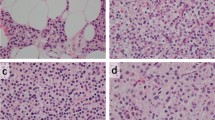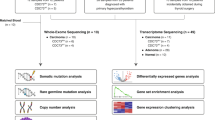Abstract
The objective of the study was to examine proliferation and apoptosis associated gene expression in the whole sequence parathyroid lesions to reveal specific features of carcinoma. This study was based on surgically removed parathyroid tissues, gene expression analysis was performed both at gene and protein level. First, mRNA isolation was performed from deep-frozen tissue samples, and further apoptosis pathway-specific cDNA macroarray analysis was carried out. The results were validated with real-time PCR. Subsequently, protein expression was analyzed with immunhistochemistry on Tissue Micro Array multi-blocks derived from several paraffin-embedded samples. cDNA macroarrays revealed elevated expression of both pro-apoptotic (FAS receptor, TRAIL ligand, CASPASE8, and −4) and anti-apoptotic (cIAP1, APOLLON) genes in benign proliferative lesions compared to that in normal gland. TMA studies showed overexpression of KI67, P53, SURVIVIN and APOLLON protein and failure of expression of P27, BCL2, BAX, CHROMOGRANIN-A, SYNAPTOPHYSIN, CYCLIND1, FLIP, TRAIL, CK8, CK18, CK19 in parathyroid carcinoma was detected. These alterations in gene expression of the investigated products could be used in differentiation between beningn and malignant proliferative processes of the parathyroid gland. Authors conclude that a series of alterations in gene expression such as overexpression of APOLLON, P53, KI67 and suppression of P27, BCL2, BAX lead to uncontrolled cell proliferation, but still not leading to increased apoptotic activity in parathyroid carcinoma.




Similar content being viewed by others
References
Fernandez-Ranvier GG, Khanafshar E, Jensen K et al (2007) Parathyroid carcinoma, atypical parathyroid adenoma, or parathyromatosis? Cancer 110(2):255–264
Adami S, Marcocci C, Gatti D. Epidemiology of primary hyperparathyroidism in Europe. J Bone Miner Res 17 Suppl 2:N18-23
Marx SJ (2000) Hyperparathyroid and hypoparathyroid disorders. N Engl J Med 343:1863–1875
Fernandez-Ranvier GG, Khanafshar E, Tacha D et al (2009) Defining a molecular phenotype for benign and malignant parathyroid tumors. Cancer 115(2):334–344
Stojadinovic A, Hoos A, Nissan A et al (2003) Parathyroid neoplasms: clinical, histopathological, and tissue microarray-based molecular analysis. Hum Pathol 34(1):54–64
Szende B, Farid P, Végso G et al (2004) Apoptosis and P53, Bcl-2 and Bax gene expression in parathyroid glands of patients with hyperparathyroidism. Pathol Oncol Res 10(2):98–103
Vargas MP, Vargas HI, Kleiner DE et al (1997) The role of prognostic markers (MiB-1, RB, and bcl-2) in the diagnosis of parathyroid tumors. Mod Pathol 10(1):12–17
Hadar T, Shvero J, Yaniv E et al (2005) Expression of p53, Ki-67 and Bcl-2 in parathyroid adenoma and residual normal tissue. Pathol Oncol Res 11(1):45–49
Szende B, Arvai K, Peták I et al (2006) Changes in gene expression in the course of proliferative processes in the parathyroid gland. Magy Onkol 50(2):137–140
Solcia E, Kloppel G, Sobin LH (2000) Histological typing of endocrine tumours; international histological classification of tumours. WHO Ed. 2. Springer; p.48–55
Shane E, Bilezikian JP (1982) Parathyroid carcinoma: a review of 62 patients. Endocr Rev 3(2):218–226
Favia G, Lumachi F, Polistina F et al (1998) Parathyroid carcinoma: sixteen new cases and suggestions for correct management. World J Surg 22(12):1225–1230
Hundahl SA, Fleming ID, Fremgen AM et al (1999) Two hundred eighty-six cases of parathyroid carcinoma treated in the U.S. between 1985–1995: a National Cancer Data Base Report. Cancer 1;86(3):538–44
Busaidy NL, Jimenez C, Habra MA et al (2004) Parathyroid carcinoma: a 22-year experience. Head Neck 26(8):716–726
Haven CJ, Howell VM, Eilers PH et al (2004) Gene expression of parathyroid tumors: molecular subclassification and identification of the potential malignant phenotype. Cancer Res 64(20):7405–7411
Woodard GE, Lin L, Zhang JH et al (2005) Parafibromin, product of the hyperparathyroidism-jaw tumor syndrome gene HRPT2, regulates cyclin D1/PRAD1 expression. Oncogene 10;24(7):1272–6
Cetani F, Pardi E, Ambrogini E et al (2007) Different somatic alterations of the HRPT2 gene in a patient with recurrent sporadic primary hyperparathyroidism carrying an HRPT2 germline mutation. Endocr Relat Cancer 14(2):493–499
Iacobone M, Masi G, Barzon L et al (2009) Hyperparathyroidism-jaw tumor syndrome: a report of three large kindred. Langenbecks Arch Surg 394(5):817–825
Yang Y-J, Han J-W, Youn H-D et al (2010) The tumor suppressor, parafibromin, mediates histone H3 K9 methylation for cyclin D1 repression. Nucleic Acids Res 38:382–390
Masi G, Barzon L, Iacobone M et al (2008) Clinical, genetic, and histopathologic investigation of CDC73-related familial hyperparathyroidism. Endocr Relat Cancer 15(4):1115–1126
Shih RY, Fackler S, Maturo S et al (2009) Parathyroid carcinoma in multiple endocrine neoplasia type 1 with a classic germline mutation. Endocr Pract 15(6):567–572
Cetani F, Ambrogini E, Viacava P et al (2007) Should parafibromin staining replace HRTP2 gene analysis as an additional tool for histologic diagnosis of parathyroid carcinoma? Eur J Endocrinol 156(5):547–554
Howell VM, Gill A, Clarkson A et al (2009) Accuracy of combined protein gene product 9.5 and parafibromin markers for immunohistochemical diagnosis of parathyroid carcinoma. J Clin Endocrinol Metab 94(2):434–441
Acknowledgements
This work was supported by a grant of the Hungarian National Science and Research Foundation (OTKA T46665) grant. The authors would like to thank Tibor Vaszkó for his valuable comments to improve the manuscript.
Declaration of interest
The authors confirm that there are no conflicts of interest.
Author information
Authors and Affiliations
Corresponding author
Rights and permissions
About this article
Cite this article
Árvai, K., Nagy, K., Barti-Juhász, H. et al. Molecular Profiling of Parathyroid Hyperplasia, Adenoma and Carcinoma. Pathol. Oncol. Res. 18, 607–614 (2012). https://doi.org/10.1007/s12253-011-9483-7
Received:
Accepted:
Published:
Issue Date:
DOI: https://doi.org/10.1007/s12253-011-9483-7




